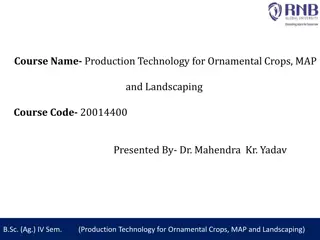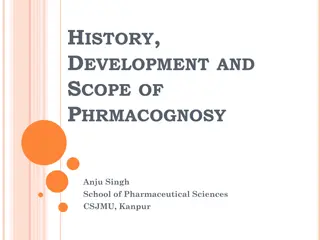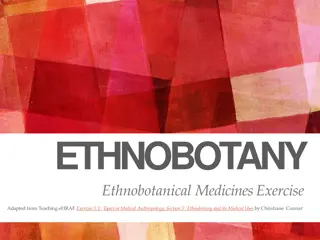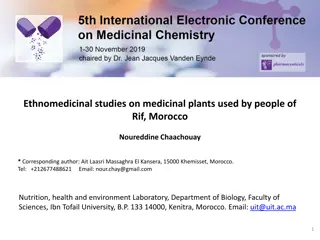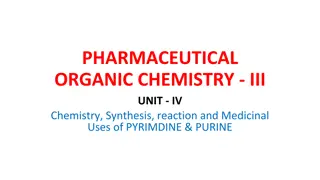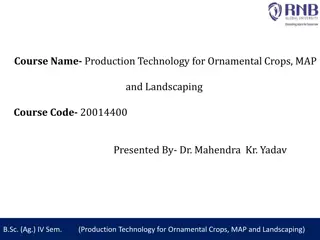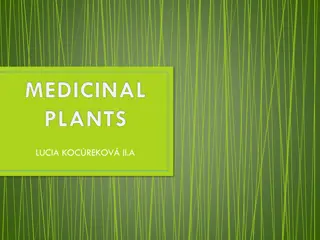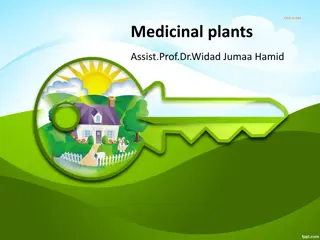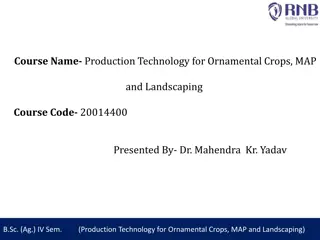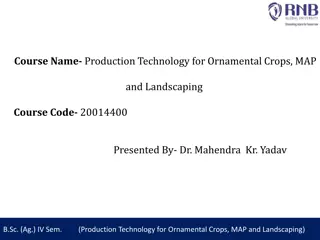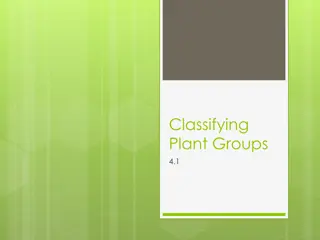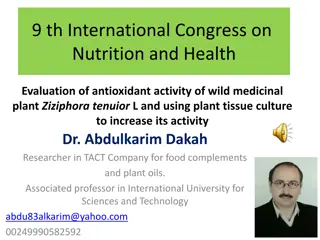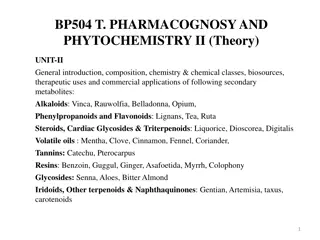
Medicinal Plants - Tulsi and Giloy: Uses, Benefits, and Chemical Constituents
Discover the fascinating world of two potent medicinal plants - Tulsi and Giloy. From their morphology to chemical constituents and traditional uses in Ayurveda, explore the rich benefits these plants offer for various health conditions.
Download Presentation

Please find below an Image/Link to download the presentation.
The content on the website is provided AS IS for your information and personal use only. It may not be sold, licensed, or shared on other websites without obtaining consent from the author. If you encounter any issues during the download, it is possible that the publisher has removed the file from their server.
You are allowed to download the files provided on this website for personal or commercial use, subject to the condition that they are used lawfully. All files are the property of their respective owners.
The content on the website is provided AS IS for your information and personal use only. It may not be sold, licensed, or shared on other websites without obtaining consent from the author.
E N D
Presentation Transcript
1. OCIMUM TENUIFLORUM ( Synonym : Ocimum sanctum ) English names : Holy basil Indian names : Tulsi, Surasa Family : Lamiaceae
MORPHOLOGY : (Tulsi) is an erect, much branched sub-shrub 30-60 cm tall, with simple opposite green or purple leaves that are strongly scented and hairy stems. Leaves have petiole and are ovate, up to 5 cm long, usually somewhat toothed. Flowers are purplish in elongate racemes in close whorls. Seeds of basil are black in colour.
CHEMICAL CONSTITUENTS : Essential oil from leaves contains methyl cinnamate , 1- linalool, terpinene, macinnamate, methyl chavicol, ocimeme, borneol, sambulene and safrole. PART USED : leaves USES : Tulsi can help cure fever. Tulsi leaves are used to treat skin problems like acne, blackheads and premature ageing. Tulsi is used to treat insect bites. Tulsi is also used to treat heart disease and fever. Tulsi is also used to treat respiratory problems.
MAJOR AYURVEDIC FORMULATIONS: Shankhpushpi oil, Honey tus, Herbollin Tablet. Pathrina Tablets, Tomset Capsule, Vilwadi Gulika Shwasahara Kashaya, Chemparathyadi Keram, MaktadiMahanjana, Bala Thailam and Dayal Tailam.
2. TINOSPORA CORDIFOLIA English names : Heartleaf moonseed, Indian tinospora. Indian names: Giloy, Gulancha (Hindi), Guduchi, Amritavalli. Family: Menispermaceae. Plant is commonly known as Giloe which is a Hindu mythological term that refers to the heavenly elixir that has saved celestial beings from old age and kept them eternally young . It is also found in Burma and Sri Lanka.
MORPHOLOGY Stem and branches are specked with white vertical lenticels. Bark is grey-brown or creamy white, warty, papery thin, and peels off easily. Leaves are 5 15 cm, ovate, and acute. They are membranous when young but become more or less leathery with age. The seeds are curved. Flowers are fleshy and single seeded and grows during summer and fruits occur during winter.
CHEMICAL CONSTITUENTS : Therapeutic properties attributed to giloin, giloinin, gilosterol and berberine (stem bark), tinosporin tinosporom. Tinosporol, tinosporic acid, tinosporaside. Cordifolide and a furanoid diterpenc idetitical with columbin clerodane clerodane furanoditerpene 1. II. III. IV (plant). PART USED : stem USES : Tinospora cordifolia has an importance in traditional ayurvedic medicine used for ages in the treatment of fever, jaundice, chronic diarrhea, cancer, dysentery, bone fracture, pain, asthuma, skin disease, poisonous insect, snake bite, eye disorders.
MAJOR AYURVEDIC FORMULATIONS : Amritaastaka- kwatha, Amritasava , Giloyasatva, Rheumallin tablets , Triguni plus tablets , Kaishore-guggulu. Sudarshan- churna .
3. ALOEVERA ( Synonym : A. Barbadensis) English names : Indian aloe Indian names : Kumari, Gritkumari, Kumari Family : Asphodelacese
MORPHOLOGY It is an stem less or short stemmed plant. It grows upto 60-100 cm of height. Its leaves are thick and fleshy. They may be green to grey- green in color The flowers are yelllow or orange, about 2.5 cm long , produced on a spike up to 90cm tall. Fruits are cylindrical or ellipsoid- oblong, loculicidal, capsule. The flowers are produced in summer on a spike, each flower pendulous, with a yellow tubular corolla
Chemical constituents Chief constitutents are barbaloin, aloesin , aloesone, B- barboline, aloeanodin. Part used : Leaves Uses : Soothes Burns and Heals Wounds. Whether it s sunburn, burns, cuts and scraps aloe is the best. Reduces Arthritic Swelling. Heals Psoriasis Lesions. Gum Infections. . Eye irritations and injuries.Strains and sprains. Lung congestion. Used in products such as makeup , tissues, moisturizer, soaps, sunscreens, incense, shaving cream and shampoos.
MAJOR AYURVEDIC FORMULATIONS: Aloes compound, Bringamaladi, Cukkumtipalyadi gutika, Kumaryadi vati, Kumaryasava, Loharasayana, Rajpravartin vati.
4. RAUVOLFIA SERPENTINA : English : Indian Snakeroot Indian names : Chota chand, Dhaval barua, Sarpgandhi (Hindi), Sarpgandha (Sanskrit) Family : Apocynaceae
MORPHOLOGY: It is a perennial shrub. The roots of rauwolfia are rarely branched. The rootlets are 0.5-1mm in diameter. Pieces of rhizomes are recognised by a small central pith but it is closely resemble roots and sometimes they are attached to them small pieces of aerial stem. The external surface is grayish-yellow or light brown or brown in colour. Outer surface consist of wrinkles or longitudinal ridges with occasional scars of rootlets. Bark exfoliates readily or may leave patches of exposed wood. The drug composed of mostly small pieces which are 2-15 cm long and 3-22 mm in diameter. The shape of pieces are cylindrical, slightly tapering and tortuous.
Chemical constituents : The chemical constituents of rauwolfia are alkaloids i.e. It consist of 40 types of alkaloids(about 0.7-2.4%). Also it contain phytosterol, fatty acids, unsaturated alcohols and sugars as chemical constituents. Reserpine and rescinnamine are alkaloids which have main therapeutical effect in rauwolfia. Also it contain indole alkaloids and iridoid glycoside,7- epiloganin, which is a new sucrose derivative. It also contain ajmaline and ajmalicine.
Uses : Rauwolfia is used in the treatment of systolic hypertension. It also used in certain neuropsychiatric disorders. Ajmalicine is isolated from rauwolfia which is used in the treatment of circulatory disease. It has the property of hypotensive and tranquillizer. It is also used in anxiety condition . It is used as sedative. It stimulates the central of peripheral nervous system. Its roots have the property of increase the utrine contraction. It is also used in the treatment of intestinal disorders and anthelminthic bitter tonic and febrifuge .
MAJOR AYURVEDIC FORMULATIONS : Bipasil tablets, cardostab tablets, Kamentose tablets, Sumanas tablet , Sarpgandha Ghanvati and Siledin tablets.
5. EMBLICA OFFICINALIS (Syn. : Phyllanthus emblica) English : Emblic myrobalan, Myrobalan, Amla Indian names : Amla (Hindi), Amalika, Amla, Amlaki (Sanskrit) Family : Euphorbiaceae
MORPHOLOGY : A small to medium sized deciduous tree of 8-18 m height with thin light grey bark exfoliating e small thin irregular flakes. Branchlet are alternate, superposed and more than 100 leaves are arranged on them. Leaves are simple. Light green, sub-sessile and appear along the branchlets. Flowers are greenish yellow, in axillary clusters, unisexual, males numerous on short slender pedicels, females few, subsessile, ovary 3-celled Flower starts appearing in the beginning of spring season. Fruits are globose, fleshy, pale yellow, with six obscure vertical furrows enclosing un trigonous seeds in 2-seeded 3 crustaceous cocci.
Chemical constituents : Active constituents are due to tannins. Polyphenolic compounds 1, 3, 6-trigalloyl glucose terchebin, corialgin, ellagic acid, phyllantidine and phyllantine, terchebin (fruits, leaves), vit C. LAA.. Four other auxinsal, a3, a4, a5, two growth inhibitors R1 and R2. PARTS USED: Seed, fruit, leaves, bark and roots.
Uses : It cures rheumatoid arthritis, inflammation, diabetes, indigestion, heartburn, balance vata, pita, and kapha. It is one of Triphala constituents. It is used in dandruff and hair loss. It is rich in antioxidants which help in restricting the growth of carcinogenic cells. It is a rich source of Vit. C and provide immunity to the body and helps in reducing flu and throat infection Fruit is used for the treatment of diarrhea: jaundice, and inflammation Major Ayurvedic Formulations : Agnitundi-vati, Ambalyadi-churn. Amlaki-churn, Amla-kyadi-churn. Amlaki-rasayan. Arogya vardhini. Brahma-rasayan, Brahmi-amal tail. Brahmyarasayana; fresh fruit pulp is the mainingredient of Chayavanprash, Sanjivani-vati, Triphala-churn, Triphala-Ghrit. Triphala-Karanjaadi yog and Kabz-care.
6. CATHARANTHUS ROSEUS (Synonym: Vinca rosea) English : Cape Periwinkle , Rose Periwinkle, Rosy Periwinkle. Indian names : Sadabahar (Hindi). Ushamalry, Nithyakalyani (Sanskrit). Family : Apocynaceae
MORPHOLOGY : It is an evergreen 1 m tall herb. The leaves are oval to oblong, 2.5- 9.0 cm. Long and 1 35 cm. Broad glossy green hairless with a pale midrib and a short petiole. The flowers are white to dark pink with a dark red center, with 2.5-3 cm. Long a basal tube and a corolla about 2-5 cm diameter with five petal like lobes. The fruit is a many seeded cylindrical follicle.
CHEMICAL CONSTITUENTS : The alkaloids like Vinblastin, Vincrestine. Vindesine. Vindeline Tabersonine etc. Are mainly present in aerial parts whereas ajmalicine, vinceine, vineamine, raubasin. Reserpine, catharanthine etc are present in roots and basal stem. Flowers are rich in vinblastine, coronaridine, vindorosine, vindoline, catharanthine, mitraphlline, ajmalicine, tetrahydroal stonnie. 11-methoxytabersonineb and reserpine. PARTS USED:Leaf, root and the whole plant.
Uses : The juice of leaves is used for bee and wasp sting. Decoction of leaves is used in diabetes, stomach cramps, and in intestinal parasitism. Crude leaf and root extracts has anti cancer activity. The roots are used as purgative, vermifuge, and toothache remedies.


